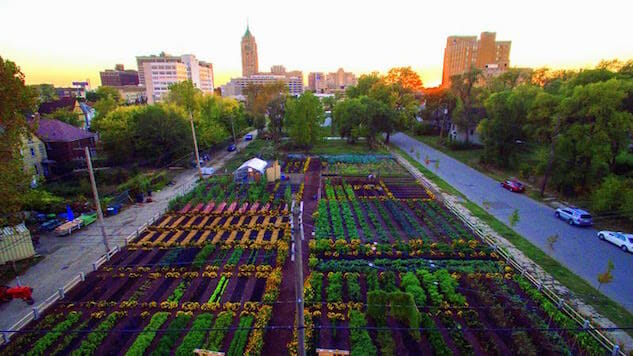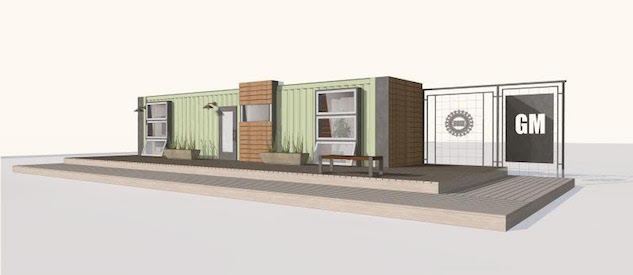EarthRx: Detroit’s New “AgriHood” is the Future of Urban Planning
Photo and images courtesy of Michigan Farming Initiative (MUFI) Science Features Urban Agriculture
The world reached a silent milestone in 2008 when the urban population overtook the rural one for the first time ever—a unique and important turning point in human history. But as someone who grew up in the inner city, I know personally that there are some facets to urban life that are not very rosy, like food scarcity, which now affects nearly 13 percent of all households in the U.S.
Being cut off from nature and access to real food is one of the things that makes the ghetto so harsh. When people lack basic needs like fresh food in the richest country in the world—a country that spends $20 billion a year on corporate welfare fossil fuel subsidies by the way—something is definitely wrong in the community design department.
That’s why when I saw the Michigan Farming Initiative (MUFI) announce last month that it had just launched what they claim to be America’s First AgriHood, I immediately contacted the volunteer-run nonprofit to find out more.
Located in Detroit’s hard hit North End neighborhood, the fledgling organization runs a two-acre urban garden, a 200-tree fruit orchard, a children’s sensory garden, is building a three-story community center/cafe and has already provided more than 50,000 pounds of fresh produce free of charge to more than 2,000 households, most of them low income.
Growing food in urban areas is nothing new in the U.S. of course. During World War II a movement of victory gardens—which were grown and managed on public spaces, parks and vacant lots in major cities—were able to provide nearly half of the nation’s fresh vegetables. But when the war ended most of these closed down as they were located on borrowed land—either state or privately owned.
After victory gardens disappeared, the nation went through a urban gardening slump until the community garden movement, something initiated in Latin American and Asian immigrant neighborhoods in NYC and LA before it was copied in hipper areas. Community gardens in the U.S. have now grown into a force to be reckoned with, and home garden food growing has also been gaining steam. According to a recent report by the National Gardening Association, food gardening in America is at its highest point in over a decade with millennials leading the way as the fastest growing segment of urban gardeners.
But while 35 percent of all households in the U.S. are now engaged in some form of food production, home and community gardening are limited by space and suffer from a lack of the kind of centralized planning and organization that real farms use to produce large quantities of food. For cities to really start feeding themselves we need to evolve more complex and efficient models of urban food production.
And that’s where Detroit’s new AgriHood really shines.
 Image courtesy of Michigan Farming Initiative (MUFI)
Image courtesy of Michigan Farming Initiative (MUFI)
“We are very high producing per square foot,” Tyson Gersh, the president, co-founder and farm manager of the project tells me. “We are much more efficient than community gardens and we are using hydroponics to dramatically increase our production model as well.”
But to me the Detroit AgriHood is unique in that it “positions agriculture as the centerpiece of a mixed use urban development.” In other words, it is urban planning that takes into account the obvious fact that people need to eat. And that’s been a long time coming.
“Basically,” Gersh tells me, “this is a residential development strategy with a working farm as the center.” Think of it like an edible Central Park surrounded by housing.
Once upon a time in another America, the historic North End of Detroit was home to middle and upper class families. But now it is a poster child of urban decline: vacant lots abound and there is only one real grocery store where anything beyond liquor store fare can be found. Anything freshly grown comes in from miles away. The AgriHood would change this completely.
But while I was getting excited about the project a problem crossed my mind. Being from San Francisco, a city where almost no middle class families remain and the poor sleep in the streets, I wondered if Gersh and crew were worried at all about gentrification issues. Seeing that Gersh says “we’ve seen an overwhelming demand from people who want to live in view of our farm,” I began wondering about the North End’s current residents and what would eventually happen to them.
“This is a very important issue,” Gersh responds when I confront him with my concerns. “Especially since over two thirds of the current residents of the North End are renters and could get priced out if rents rose dramatically.”
While Gersh would like to see the city implement a rent control policy to protect residents, something that is in the works for Detroit’s Midtown area, MUFI is also working on solutions right at the ground level.
As part of the AgriHood’s residential plan, the organization is building a model affordable housing solution made from shipping containers and materials donated by General Motors. The two-bedroom, 320-square-foot “tiny homes” will be designed to be economically accessible and used to re-populate the neighborhood’s vacant lots.
The real beauty of the AgriHood is this kind of integrated urban planning that nips a lot of potential future problems in the bud, sowing the seeds for solutions now. This is the opposite of the market-driven chaotic sprawl that has dominated American urban growth for decades.
In terms of actually feeding vast numbers of people, Gersh admits that the AgriHood has hardly “made a dent” in the food security issues of Detroit. But it doesn’t have to. It is a model for neighborhood design that if duplicated and copied across the country on a mass scale would be game changing, providing access to high quality fresh local produce and reversing harsh inner city conditions like social isolation and lack of greenery.
 Photo courtesy of Michigan Farming Initiative (MUFI)
Photo courtesy of Michigan Farming Initiative (MUFI)
Cities can grow enough food to sustain their residents; this was proven back in the victory garden days and is exemplified in places like modern Havana, where, because of the trade embargo, the city has had to become self-sufficient food wise.
In fact, across the globe major cities are ramping up local food production strategies just as corporate industrial agriculture is driving food quality and access down. Land scarce Singapore is pioneering food skyscrapers that look like futuristic takes on the hanging gardens of Babylon while Montreal has launched multiple urban farming initiatives designed to make the entire city a world model for addressing food scarcity.
All it would take in the U.S. for projects like Detroit’s new Agrihood to multiply and be implemented on a wide scale is a real public investment. While that may sound like far-fetched utopianism, there is of course that $20 billion or so that goes to the completely destructive fossil fuel industry every year that really should be repurposed for much better things.
EarthRx columnist Ocean Malandra is a widely published freelance writer that divides his time between South America and Northern California.